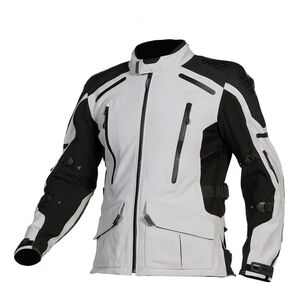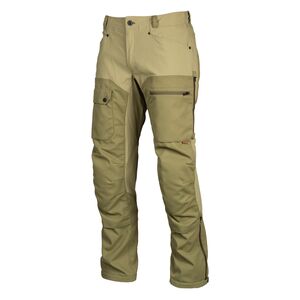If you want to argue about the best adventure-touring motorcycle in the world, there’s a good chance a number of brands from Japan and Europe will get thrown on the table. But, what if you’re trying to determine the best brand-new ADV in the world for less than $5,000? In that case, two other titans of industry will undoubtedly enter the conversation: China and India.
Home to 2.75 billion people and juggernauts of the global economy, these two countries are also the birthplace of more than 30 million motorcycles every year. A chosen few of those tens of millions are small ADV machines, destined for a burgeoning class of riders as well as foreign markets. As much fun as it is drooling over big, expensive adventure bikes with NASA-level spec sheets and automotive horsepower numbers, the idea of a legitimate and affordable adventure machine is equally attractive, and there are now more options than ever.
The contenders
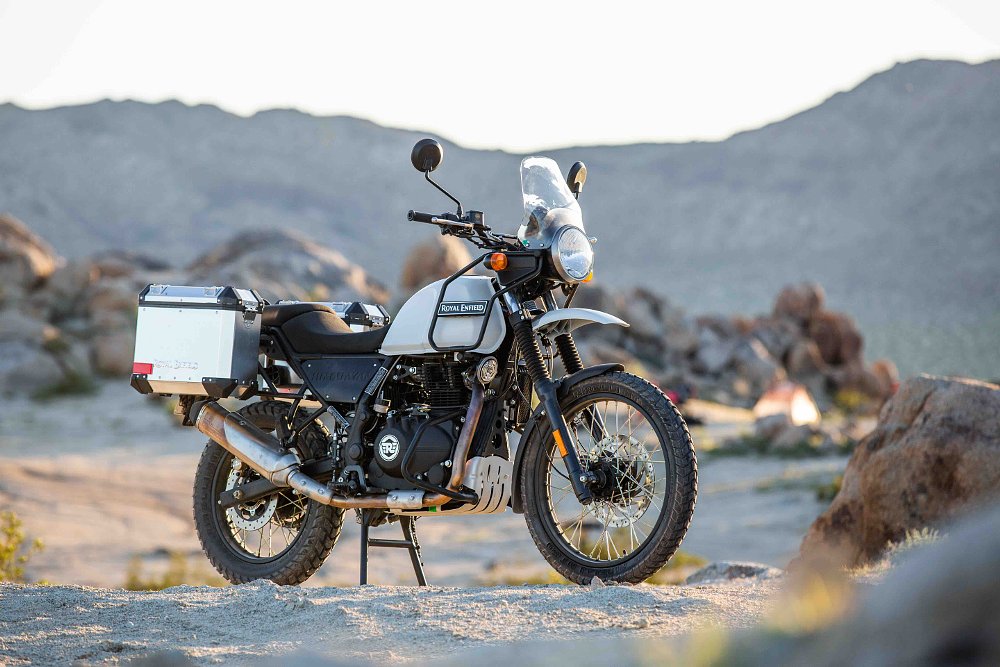
From the Asian subcontinent comes the Royal Enfield Himalayan, a 411 cc air-cooled single with horsepower in the low 20s and an aesthetic from the late ‘50s. It has a rugged, blue-collar look, and a base price of $4,749. At first glance, the Himalayan it is yet another air-cooled, single-cylinder motorcycle from the company that’s been making them since approximately the bronze age. To be fair, the LS410 engine is counterbalanced and has an overhead cam. That’s not exactly the bleeding edge of engine tech, but it is Enfield’s first clean-sheet engine design in decades and offers more tech than most Royal Enfield mills can claim.
The classic, steel, double-cradle frame is similarly antiquated, and even the Himalayan’s specs that have a whiff of adventure about them aren’t especially modern. Suspension travel is nearly eight inches in the fork and seven inches in the shock, it uses a 21-inch front wheel, and comes with lightly knobbed tires. Plus, the posture and style are decidedly old school. The round headlight perched way up high and the military-style bars running along the flanks make it look unique, and of a familiar vintage.
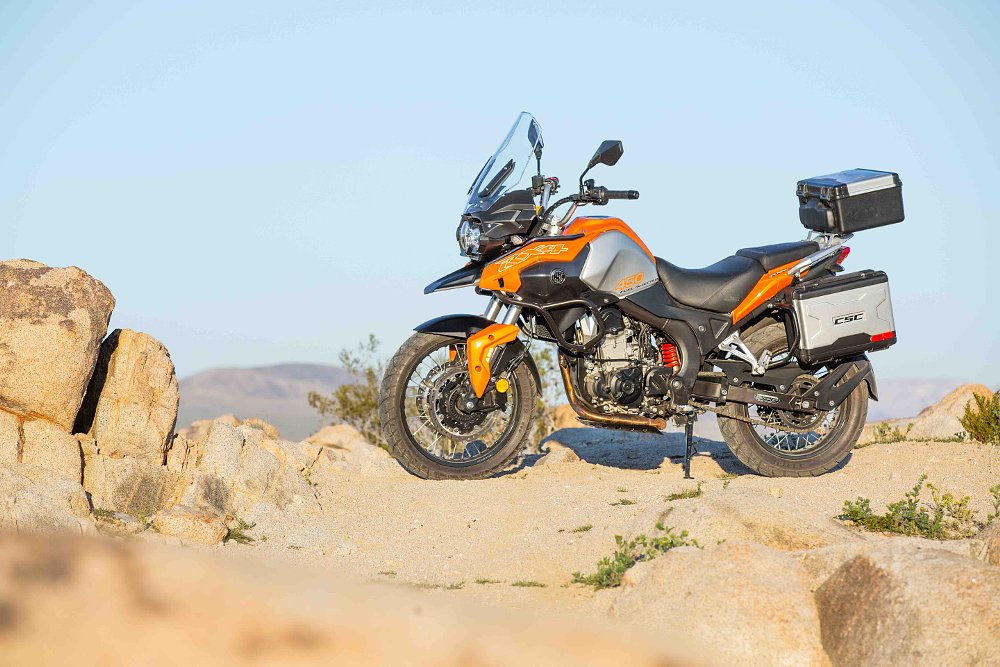
In the red corner, so to speak, is the CSC RX4, made by Chinese company Zongshen (CSC is short for California Scooter Company, the American firm that imports and brands the bikes). The RX4 uses a 40-horsepower, 450 cc liquid-cooled single to power what is ostensibly a modern take on the mid-size ADV. It’s draped in LED lighting, crash bars, and lots of features, all for an MSRP of $4,995. Basically, this CSC looks as new as the Enfield looks old. You might agree that it’s also suspiciously familiar, though, as my colleague Ari Henning pointed out in his first ride review. Instead of going retro like the Himalayan, the RX4 looks like a blend of every big ADV bike from BMW and Triumph over the past 10 years. Perhaps because of those bikes, the aesthetic works — it’s angular and asymmetrical in the right places, and the proportions are correct. It’s handsome, so long as you’ve come to accept GSs, Tigers, and Ténérés as the standard.
Actually, it goes beyond looks. The RX4 is also sprinkled with ADV features positively destined for Tierra del Fuego. There’s an adjustable windshield, 12-volt power and USB ports integrated into the cockpit, a 300-watt stator, accessory connectors prewired under the seat, adjustable suspension, a three-piece luggage set and, the $45 accessory cherry on top, a switch to toggle the rear ABS.
On paper, it was set to be a good-old-fashioned cheapskate showdown. Although, on that topic, I went over budget right off the bat by adding the top-loading aluminum cases to the Royal Enfield, which tacked on about $700 to the price. Ari could have done essentially the same, exchanging the standard aluminum-paneled plastic luggage for aluminum ones for a $400 premium, but chose instead to rub it in my face for the whole trip that his bike was cheaper. Fair enough. And so we loaded the bikes down with camping gear and dehydrated food, bid farewell to the Los Angeles Basin, and headed to the high desert north of LA to find some trouble. Along for the ride was our resident video ninja and fellow Zillian, Spenser Robert, with a camera in hand to document the adventure and create the very first episode of the Common Tread Experience.
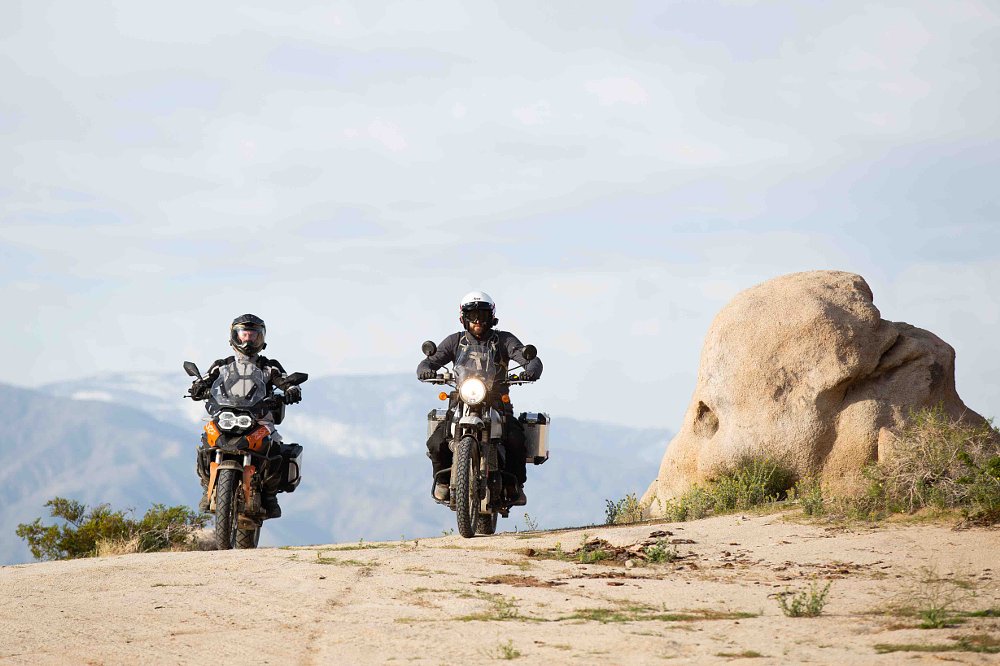
The rubber meets the road
Fire up the bikes and they each basically sound exactly like they look. In the case of the Royal Enfield the journey back in time continues. With a heavy flywheel and more stroke than bore, the muffler puts out a classic, loping thump. It’s calm and friendly, from engine demeanor to ergonomics. It’s low to the ground, and the seat and suspension are soft. Again, you get just the opposite from the CSC. It jumps to life with a high idle and a much higher-performance snap in the exhaust note. The RX4’s seat is listed at 31.9 inches, 0.4 inches taller than the Himalayan, but it feels like much more than that. Not only does the CSC’s saddle feel pretty tall, it’s also wide and stiff, just the opposite of the Enfield. Aboard the RX4 it feels like you’re sitting on top, where on the Himalayan you get the impression of sitting down in the bike.
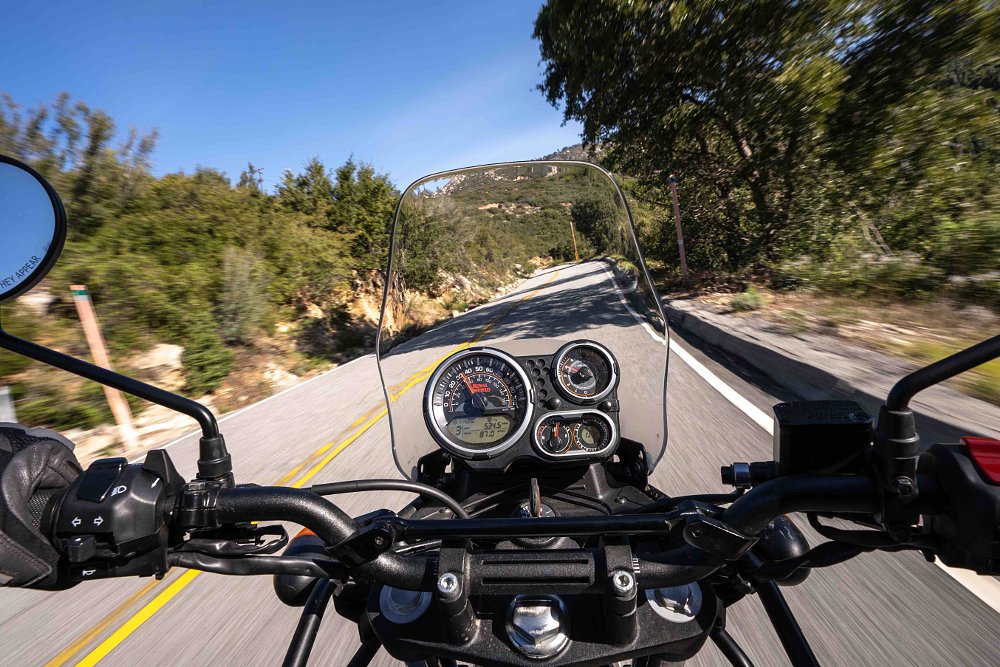
The first task when escaping the City of Angels is usually a slog on the freeway, and that’s exactly what we did with these shiny and tiny new ADVs. No big surprise, the Royal Enfield’s 24.5 claimed ponies make it feel a little slow on the freeway, but it’ll cruise at 70 or 75 mph pretty comfortably. Where other RE engines I’ve experienced feel like a paint shaker at high rpm, the counterbalancer added to this engine makes a huge difference — just don’t expect much roll-on power, and you’ll want to plan your passes carefully. The CSC on the other hand was an absolute champ on the open road. Extra power is always good, and considering the engine’s quick-to-rev, terrier character it’s amazingly smooth at speed.
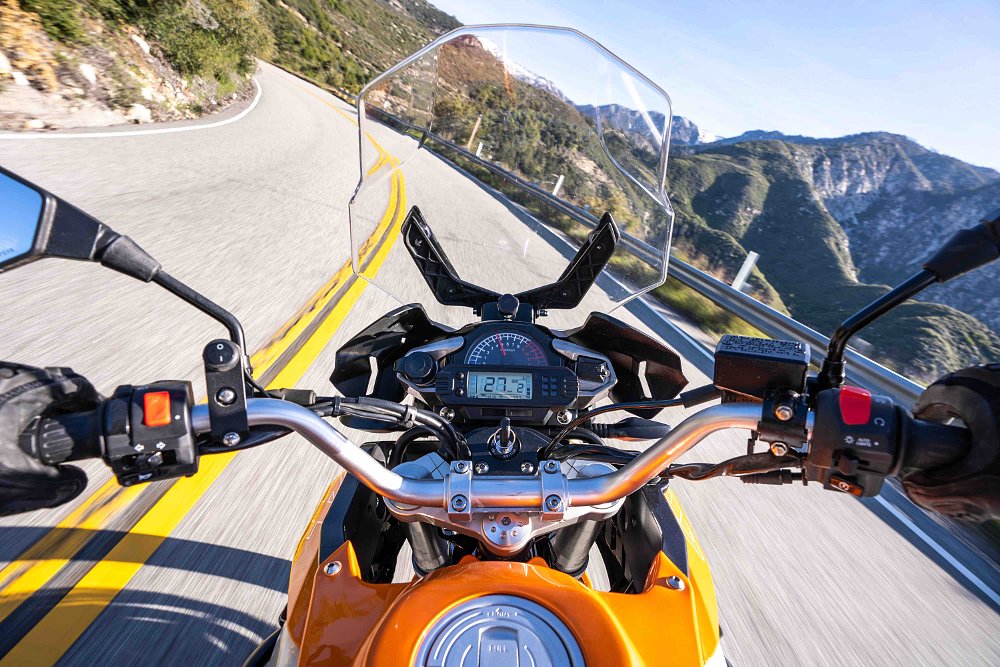
Then there’s the RX4’s adjustable windscreen, which provides good weather protection at speed, and the stiff seat proved to be a nice shape for long rides. Because the Royal Enfield’s seat feels so much lower, the seat-to-peg distance feels tighter and it’s a little harder on the knees after long highway stints. Not to mention the soft foam, which is comfy at first but eventually moves out of the way too much. I like that the Enfield is approachable, but for anyone more than six feet tall I would definitely recommend a taller, thicker seat. The small fly screen doesn’t adjust but it keeps wind off the rider’s torso surprisingly well, in part because of the heavily scooped saddle.
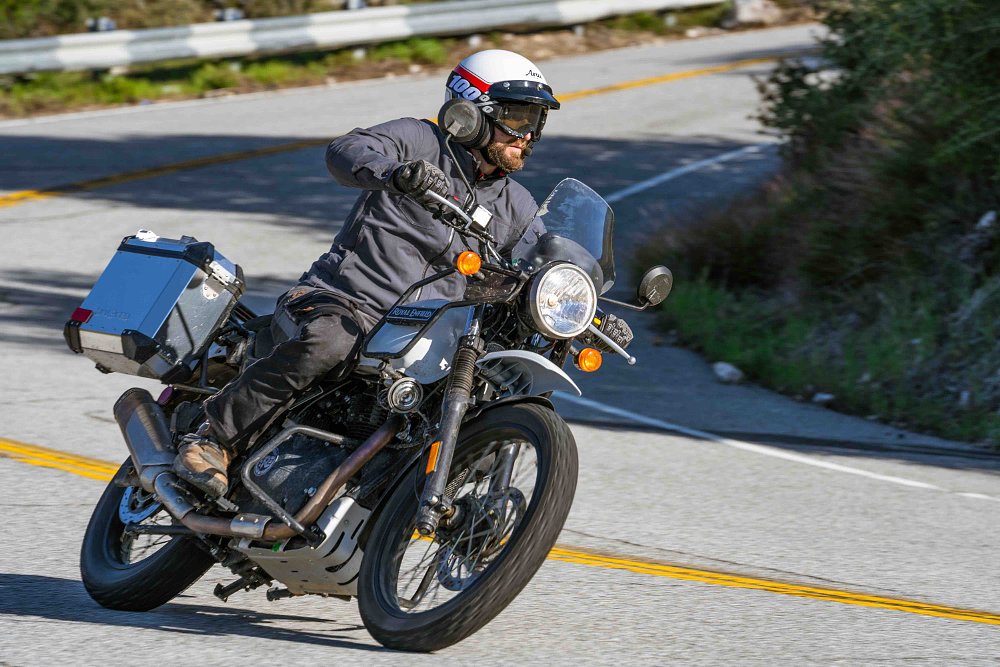
As often happens near mountains, the roads became narrower and twistier as we climbed. The sport-touring test was on, and the Himalayan was as predictable and calm as ever. Cruising through gentle sweepers and tight switchbacks is just fine, and the quasi-knobby tires gripped two-lane tarmac with plenty of confidence. One thing’s for sure, even with steel-braided lines the front brake is terrible. Ari commented that it’s almost ironic that the bike has ABS considering you’d need an icy road to lock the front wheel. Aside from that, it’s a pleasant machine in circumstances like these, as long as you don’t want to go, stop, or turn with any real urgency.
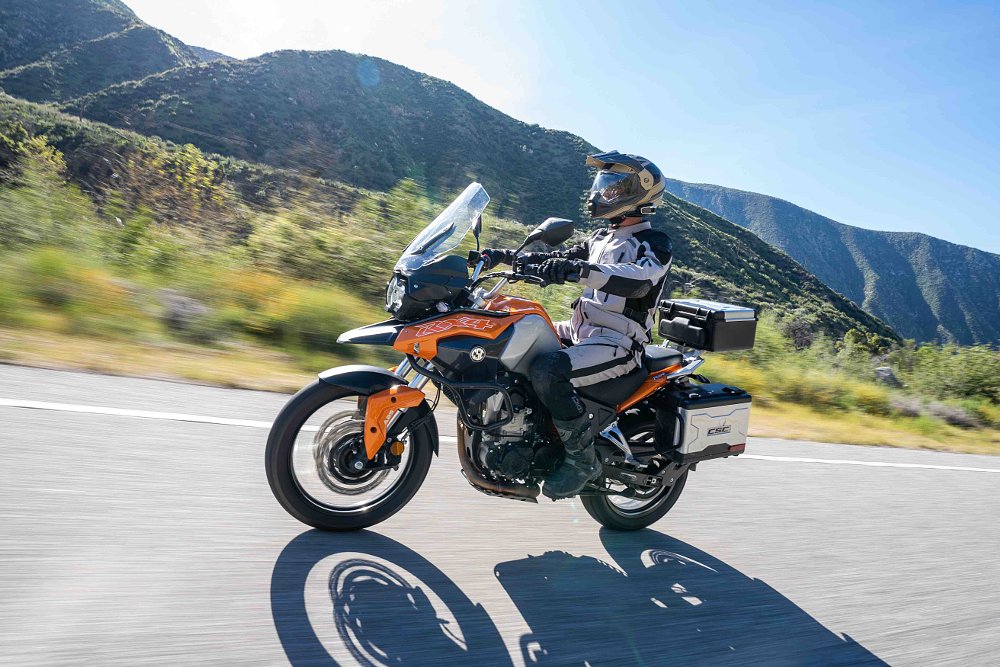
The CSC’s dual-rotor, radial-mount caliper front brake setup is both considerably better than the Enfield and pretty bad in general — it’s powerful enough, there’s just no discernable feel and initial bite is weak. The RX4 will dance through corners nicely though, and because of the smaller front wheel and stiff suspension feels more agile in general. Where it suffers most is horrendous fueling. Steady throttle on the highway let the engine purr along happily, but when it comes to rolling the throttle on and off for any reason, curves or traffic, it’s worse than any other bike either of us can remember. As a straight-up touring rig, then, the CSC had the Royal Enfield licked. As the going got slower and more technical, the Himalayan started to come into its own. We peeled off the beaten path, headed for a notch in the north side of the San Bernardino Mountains, and left the pavement behind.
Do they break if you take them off road?
Both bikes handled bopping down smooth dirt roads just fine, though it was clear from the first stretch of raw earth under the tires that the Enfield was much more at home. While the CSC’s 19-inch front wheel and road-biased tires certainly didn’t help, it was mostly the stiff suspension that betrayed its ADV sensibilities. As the roads got steeper, and then turned into wide trails, the RX4’s savvy features mattered less and less. Carrying 5.3 gallons of gas up high (plus camping gear) with ultra-stiff suspenders and a tall seat isn’t exactly a recipe for a good off-roader. Ari can attest to this, as he was the poor sap aboard the CSC for the climb through the mountains. The front tire deflected easily and didn’t offer any useful feedback, plus he was fighting the light-switch fuel injection and a grabby clutch. It was no picnic.
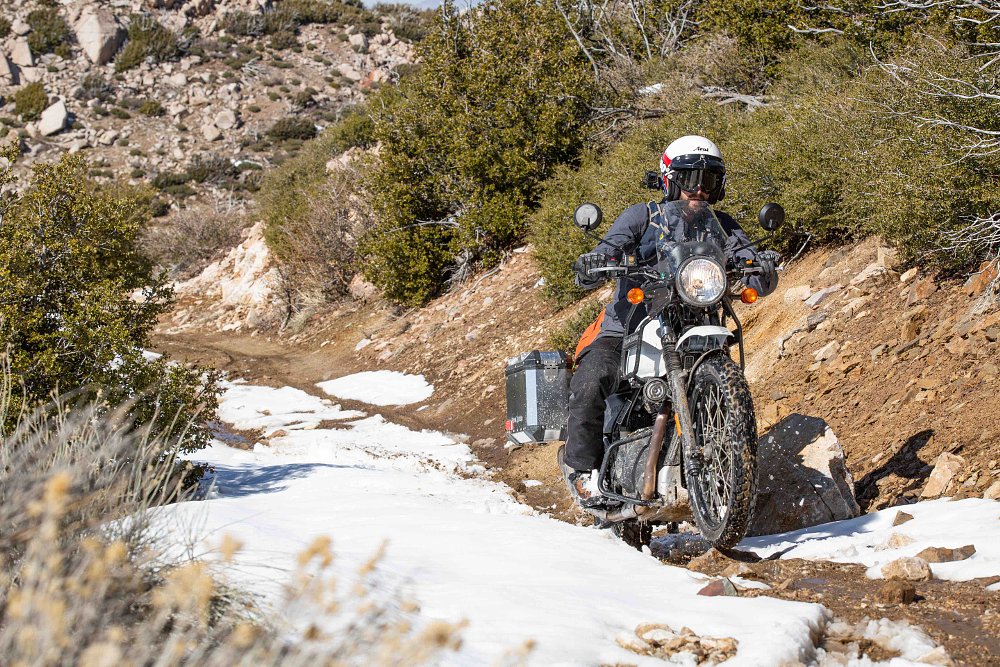
Just ahead on the trail, life was good for me on the Himalayan. The tall handlebar makes it pretty comfortable to stand up, and the lopey engine loves trotting along at a couple dozen miles per hour. I picked my way through rutted swaths of road and sand washes with very little drama, the Enfield’s soggy suspension soaking up everything in its path. On a few occasions I got a little too confident and frisky, visions of air-cooled Dakar flashing through my head, and I picked up the pace. In every case the Himalayan reminded me, by bottoming the suspension or dragging its belly, that it is not a dirt bike.
Eventually, both Ari and I hit the deck and the bikes with us. You might have the same concern we did when we headed out on this journey, which is that “adventure” bikes from China and India would simply fall apart if dragged down a dirt road for a hundred or so miles. Royal Enfield has a pretty good reputation in this department, in so much as the Indian market (and Indian roads) over the past number of decades have demanded that the bikes can take a beating and still be reliable. Let’s be polite and say that CSC’s pedigree is a little less obvious.
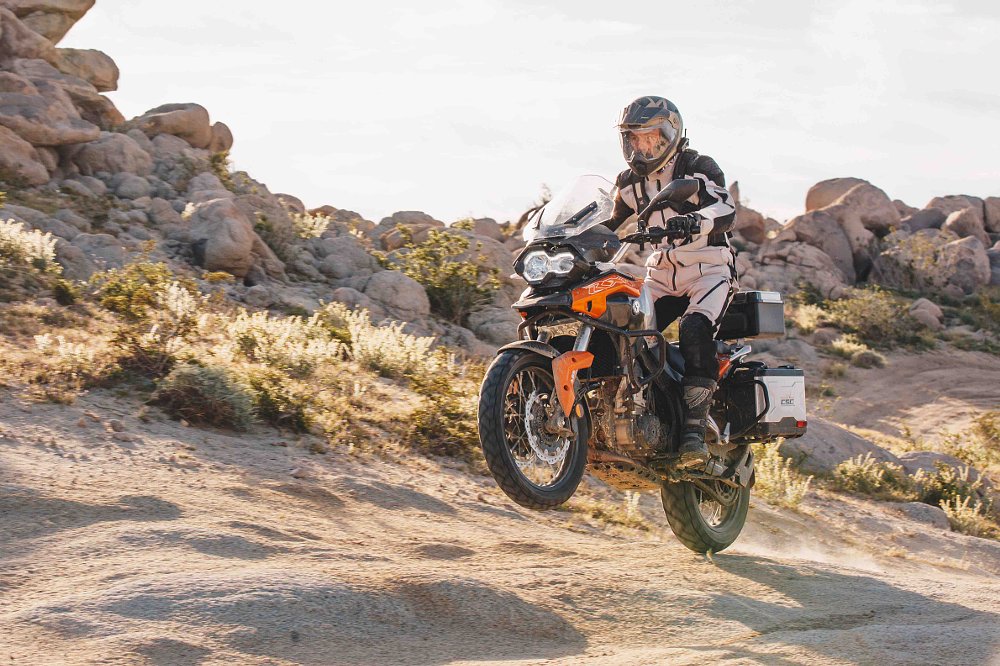
We lost count of how many times the RX4’s unwieldy nature led to a tip-over on its right side, all we know is that the first time busted the mirror and the second bent the handlebar pretty significantly. Beyond that, the crash bars did their job and the plastic luggage even took a few hard hits without breaking. I managed to sling the Himalayan off the trail after losing control on a slippery climb and it came to rest inelegantly on a rocky embankment. Still, no damage beyond breaking the tip off the front brake lever — I had notched it with a file before we left, and my premonition served us well. The Enfield’s lower crash bars were a little flimsy, to be honest, but even though they bent back after a couple of hits they did serve their tour honorably. The only questionable item regarding durability was the CSC’s handlebar mounts, which slowly loosened over the two days on the trail (we hadn’t packed the long ratchet extension needed to get to the bolts). Aside from that, the two riders were clearly the reason for everything that broke.
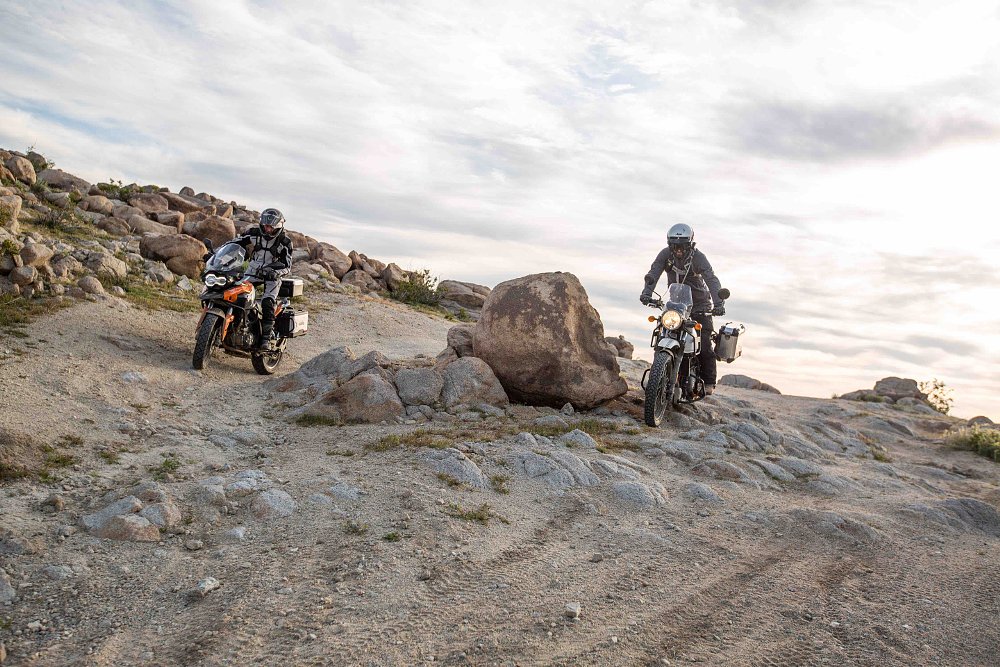
But do they feel cheap?
Once we had made our way through the snowy mountain pass and the roads began to smooth out again, we started reflecting on what the word “cheap” really means in this context. The build quality seems higher on the Royal Enfield, with fewer plasticky parts and a little more direction in its design. Even though the little, two-color LCD section of the dash feels dated, the cockpit somehow feels kind of stately and classic. At certain rpm the needles on the speedo and tachometer get a little blurry, and the thermometer in the display is hilariously inaccurate. Like I said, classic. Overall though, it feels like a fairly tight package — a bike that’s been thought out, or at least tested rigorously, even if it uses old technology.
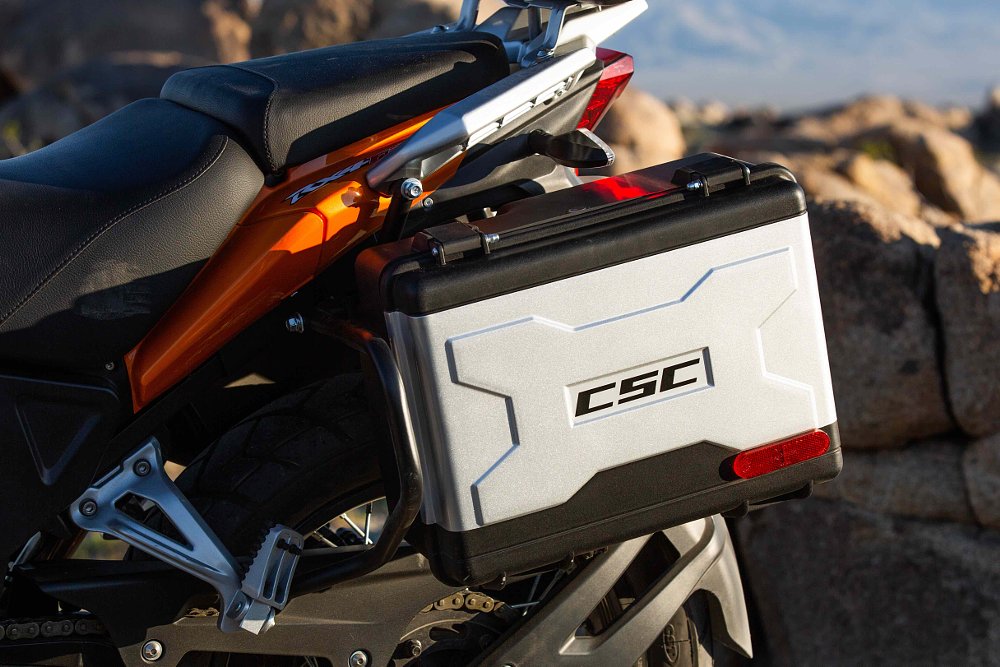
The CSC didn’t fare as well in our opinion, and we’ll admit that part of the problem is that it doesn’t have the retro theme to lean on. When a bike looks like a miniature BMW GS, you can’t help but have a certain expectation in your mind when you approach it. And when the windshield adjuster backs all the way out of the assembly into your hand, that image takes a hit. The latches on the saddlebags are flimsy, it often stalls for no apparent reason, the indicator lights on the dash are oddly dim, and the ABS switch didn’t actually work as far as we could tell. Combine all of this with a difficult drivetrain, from the fueling to clutch feel to transmission lash, and that word “cheap” bubbles to the surface. The brilliant LED headlight and smoothness at cruising speeds were genuinely impressive, no question. Apart from that it feels like an amalgamation of parts that don’t have anything in common aside from not costing a lot to manufacture.
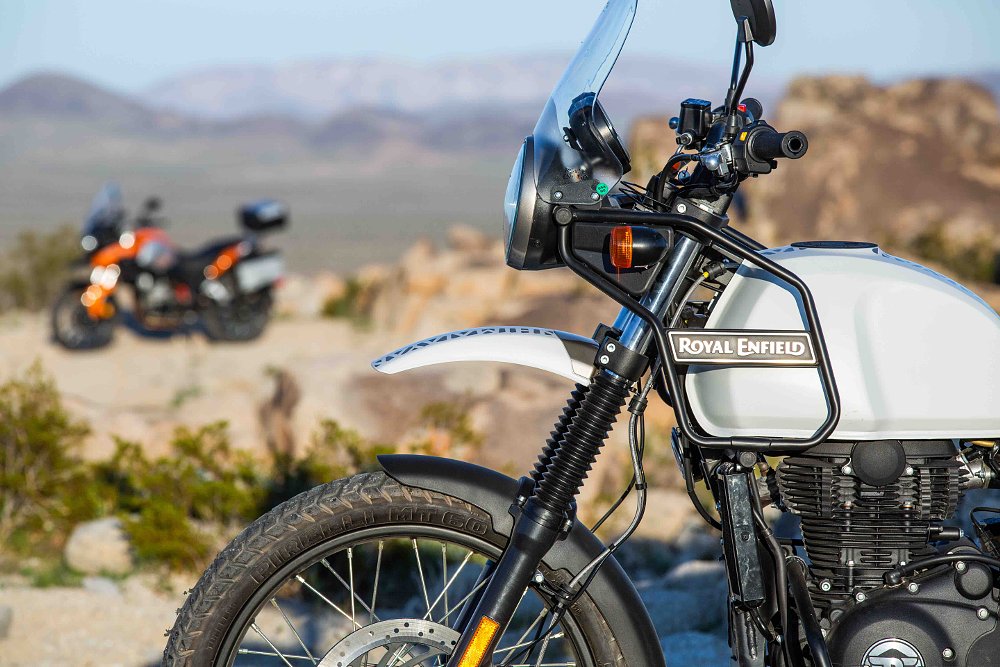
Another take on “cheap” is cost of ownership, where we can all agree that it’s no longer a dirty word. We said at the beginning of the trip that the real winner of the cheapskate ADV challenge would be the one with the smaller repair bill at the end of the ride. As it happened, even with the CSC taking the brunt of the damage it didn’t add up to much. Replacing the mirror was $15, and the handlebar $47 — hard to complain about that. The Himalayan’s front brake lever was $14 and the kickstand, which I broke the spring tab off of in one of the many rock gardens we crossed, came in at a little under $30. Parts are cheap, in other words, which will help offset costs (personal or financial) associated with checking and adjusting the valves every 5,000 miles on the CSC and 3,100 miles on the Enfield. Affordability can be a cruel mistress.
Get to the point
Right, so they have their flaws but they held up pretty well when we smashed them against stuff. What else? It’s probably prudent to note that even though the engines are small, these are not meant to be dual-sports. We torture tested the bikes, and ourselves, with a gnarly off-road route, but that was only for science. And entertainment. We truly wanted to know if they would tolerate the same thrashing we’ve given bigger ADVs over the years, and we learned that they will. However, they are small-displacement, adventure-touring motorcycles.
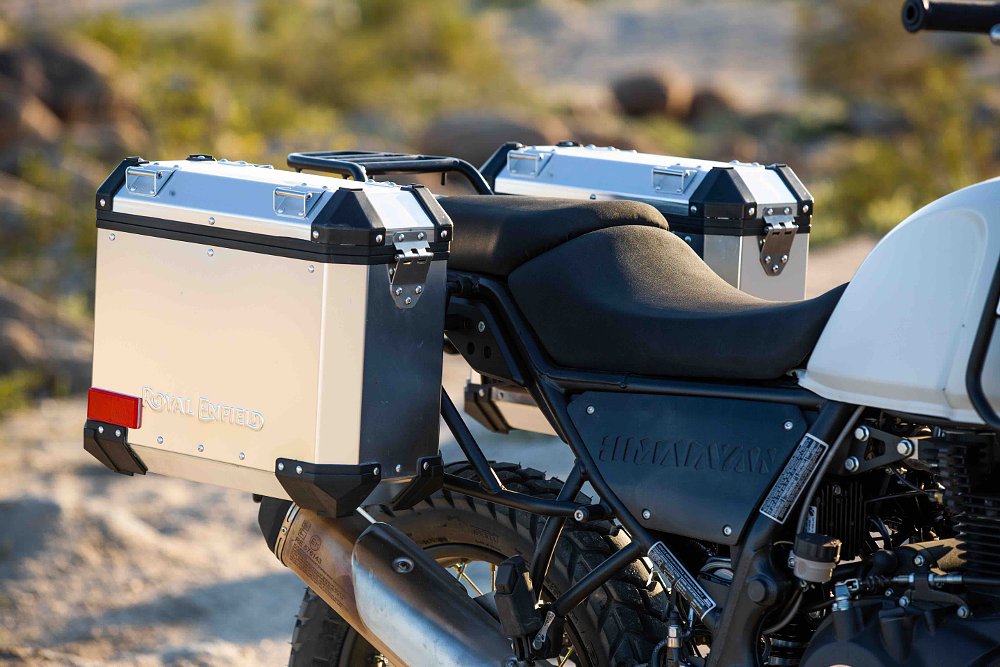
If you wanted to skip down the highway just far enough to enjoy off-road riding there are certainly some other options. Not least of which the bike our camera guy, Spenser, was riding; Honda’s venerable CRF250L. It’s engineered in Japan, made in Thailand, and you can even add soft luggage, as he did, to go camping. Range is lousy, but it’s only a few hundred more dollars brand new and it’s much better off-road. Last, but somehow never least, I’m sure most of you are thinking that a used KLR650 from Craigslist-asaki would really do the trick here. And you’d be right. For five grand a discerning shopper could put together a pretty keen KLR, easily capable of taking on the challenges we did on this ride. It wouldn’t have a warranty, but with a uranium half life that probably won’t matter.
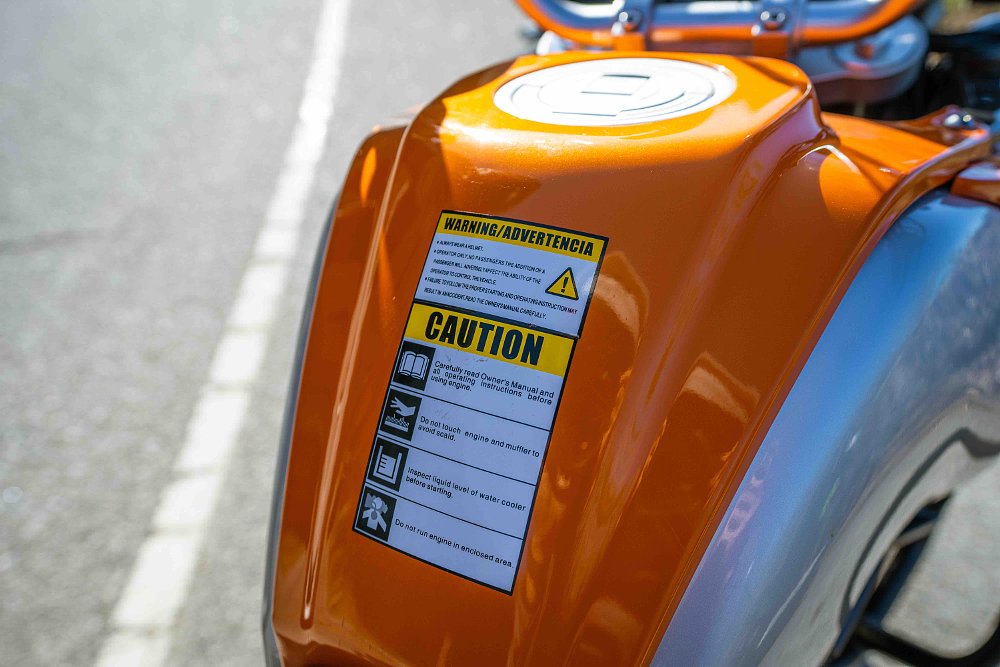
What it really came down to in the India versus China ADV showdown was general likeability. Both machines conquered what we threw at them, hauled everything we strapped on board, and made it home to ride another day. Crucially, the Royal Enfield was the only one that was as loveable as it was capable. The CSC RX4 is difficult and frustrating to use in almost any situation that isn’t the freeway. It’s loaded with features and can be delivered to your door for only a hair over $5,000, but it’s also less than the sum of its parts. Simple as it is, the Himalayan is delightful. The front brake sucks, it’s slow, the headlight and transmission work like they’re 40 years old, and yet it’s absolutely charming.
As with other Royal Enfields, this bike doesn’t deliver any performance or experience that hasn’t been widely available for decades. What it does do is feel different and special, which is no easy feat in the modern motorcycling landscape. It isn’t supposed to be a smaller and cheaper version of something else. It is unique — its own machine with its own look, mantra, and feel. The Himalayan is unlikely to steal market share from adventure riders looking for power, electronic suspension, and cruise control. Then again, as far as the best ADV in the world is concerned, it’s closer to the top than we thought.
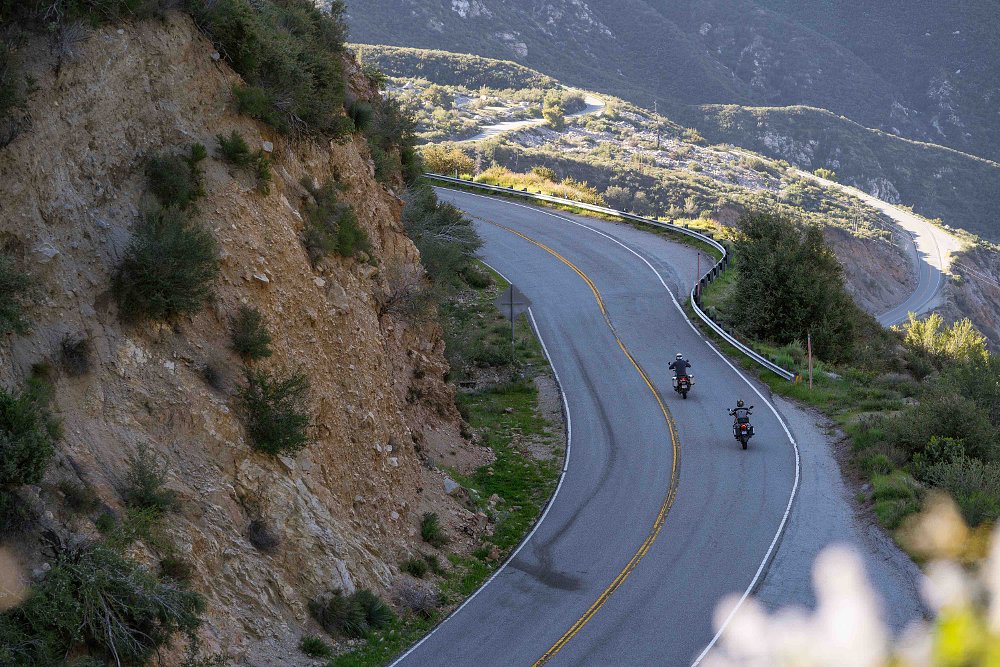
| 2020 CSC RX4 | 2020 Royal Enfield Himalayan | |
|---|---|---|
| Price (MSRP) | $4,995 | $4,749 |
| Engine | 449 cc, liquid-cooled, four-valve single | 411 cc, air-cooled, two-valve single |
|
Transmission, final drive |
six-speed, chain | five-speed, chain |
| Claimed horsepower | 40.2 @ 8,000 rpm | 24.5 @ 6,500 rpm |
| Claimed torque | 27.3 foot-pounds @ 7,000 rpm | 23.6 foot-pounds @ 4,250 rpm |
| Frame | Steel twin-spar | Steel double-cradle |
| Front suspension | CSC 41 mm fork, adjustable for spring preload and rebound damping | Gabriel 41 mm fork; 7.9 inches of travel |
| Rear suspension | CSC shock, adjustable for spring preload and rebound damping | Gabriel single shock, adjustable for spring preload and rebound damping; 7.1 inches of travel |
| Front brake | CSC four-piston calipers, ~300 mm discs with ABS | Bybre two-piston caliper, 300 mm disc with ABS |
| Rear brake | CSC single-piston caliper, ~240 mm disc with ABS | Bybre single-piston caliper, 240 mm disc with ABS |
| Rake, trail | 26.0 degrees, 4.6 inches | 26.0 degrees, 4.4 inches |
| Wheelbase | 56.1 inches | 57.7 inches |
| Seat height | 31.9 inches | 31.5 inches |
| Fuel capacity | 5.3 gallons | 4.0 gallons |
| Tires | CST, 110/80R19 front, 150/70R17 rear | Pirelli MT60, 90/90R21 front, 120.90R17 rear |
| Claimed wet weight | 450 pounds | 430 pounds |
| Available | Now | Now |
| Warranty | 24 months | 24 months |
| More info | www.cscmotorcycles.com | www.royalenfield.com |














